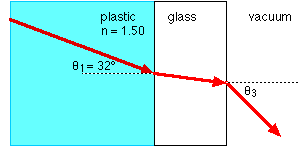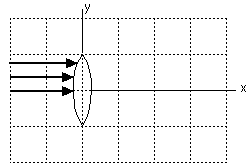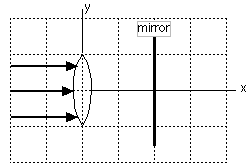
[25 points] 5. Refraction.
A light ray traveling through some plastic has a frequency of 5.5 x 1014 Hz. It is incident upon a flat slab of glass, making an angle of 32° with the normal to the interface; it passes through the glass and into vacuum, as shown in the sketch. The refractive index of the plastic is 1.50. The refracted ray in the glass has a wavelength of 321 nm.

[5 points] (a) What is the refractive index of the glass?
[10 points] (b) What is the angle of refraction (measured from the normal) for the light ray in vacuum?
[10 points] (c) What is the minimum angle of incidence (in plastic) for which the ray will be totally internally reflected at the glass-vacuum interface?
[10 points] 6. Refraction and reflection.
Three parallel rays are incident on a converging lens; the lens has a focal
length of 3.0 cm. In each of the two cases below, draw the path of each light
ray and state the x and y coordinates of the point where the rays converge.
Assume the lens lies at the origin of an x-y coordinate system, and the grid
has a spacing of 1 cm by 1 cm.
[5 points] (a) The rays are parallel to the principal axis, and shine on the upper half of the lens.

The rays converge at: x = ______ cm y = ______ cm
[5 points] (b) The rays are parallel to the principal axis; a plane mirror is placed at x = 2 cm, parallel to the y-axis.

The rays converge at: x = ______ cm y = ______ cm